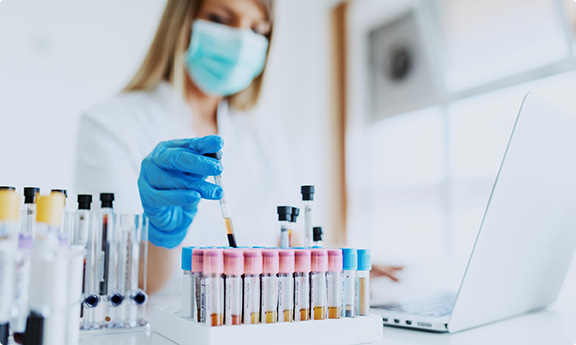
Coronavirus Testing (COVID-19)
Antigen rapid test with sampling by medical staff
Antigen rapid assays detect the presence or absence of an antigen. These tests are relatively inexpensive, can be performed quickly, and can also be performed at a point of care (POC, such as in a nursing home). Currently, the sensitivity of available antigen assays is significantly lower than that of molecular assays (PCR). The APHL recommendations for antigen tests apply only to tests for the detection of viral infection, and the detection of infection does not necessarily correlate with the infectious condition . Currently, only limited data are available between the positivity of an antigen test and the ability to transmit a virus.
Overview of SARS-CoV-2 antigen rapid bodies
Antigen tests are usually performed by pharyngeal or nasal sampling and the smear is added to some transport medium.
antigen tests target specific proteins of the virus and use them to detect infection. Currently, FDA-approved rapid antigen assays target the SARS-CoV-2 nucleucapsid protein.
antigen tests give a rapid qualitative result on the presence of SARS-CoV-2. They do not give a quantitative result.
in populations with high SARS-CoV-2 positivity, positive tests confirm the presence of SARS-CoV-2 antigen, ie in this case the test indicates infection of the test subject and is likely to indicate infectivity , although data supporting this correlation are not yet conclusive
currently available rapid antigen assays are less sensitive than molecular assays. False negative tests may occur regardless of true disease prevalence data. Where appropriate, a negative result produced by a rapid antigen test should be verified by a more sensitive (PCR) molecular test.
Despite high specificity, false positive tests may also occur, now commonly in populations with low transfection rates. If a false positive test is suspended, the subject should be retested by molecular test (PCR).
Direct detection of coronavirus, COVID-19 (PCR test)

SARS-COV-2 is a 90 nanometer wide virus. Four different proteins as well as a single beach It is made up of RNA, which stores the genetic information of the virus. One of the four proteins is the virus located in a lipid sheath, protruding from there gives a crown-like appearance. Two proteins in the “crown” is located between the spikes, and the fourth is located within the lipid membrane around which
ligated RNA of 29,900 nucleotides. The relationship between the human cell and the virus is the cells through ACE-2 proteins (receptors) on its surface. The virus envelope is second protein binds to the protein breakdown (protease) enzyme TMPRSS2 on the surface of cells, making it allow the virus to enter cells.
.
making it allow the virus to enter cells. Upon entering the cells, the envelope of the viral protein breaks down, and it The RNA thus released binds to the ribosomes and then replicas (multiplier) enzyme production. Due to the function of the replicase enzyme, viral RNA copies are large are produced in numbers.
The new viral RNA copy around due to the assembly of the four types of proteins a new protein coat is formed. With this, new infectious viruses are created, giving new cells are able to infect. A single human cell can “produce” 100-1000 new viruses.
Not all newly replicated RNAs are built around the protein envelope. There are un-free RNA which enter the bloodstream, pharynx and nasal secretions. From RNA samples enriched here PCR (polymerase chain reaction) is used to detect coronavirus RNA, i.e. coronavirus proof of infection.
To the best of our knowledge, COVID-19 viral RNA can be detected between 5 and 6 days after infection from nasal and pharyngeal samples. To the best of our knowledge, coronavirus infection with PCR is a can be demonstrated as early as 1-2 days before the onset of clinical symptoms.
Important: Eating, drinking (including coffee), smoking, chewing and brushing your teeth (to avoid dilution of the pathogen) are strictly forbidden for 4-6 hours before sampling.
Detection of antibodies from venous blood sampling
To the best of our knowledge, COVID-19 virus RNA can be detected in nasal and pharyngeal samples between 5 and 6 days after infection. To the best of our knowledge, PCR can be used to detect coronavirus infection 1-2 days before the onset of clinical symptoms. All pathogens, including viral infections, trigger the body’s defense mechanism, first IgM and then IgG-type antibodies can be detected. Antibody tests always detect antibodies produced against a specific protein of the pathogen.
To the best of our knowledge, IgM (early) type antibody can be detected in the blood 8-9 days after infection, IgG type (late) antibody 10-11 days after infection (whole blood, blood serum, or blood plasma).
| The day after infection | What can be detected | From what pattern | Method | How many samples can be tested at one time in the lab | How long is the test time in the lab | How many days it can be shown Who |
| 5-6 days | Virus RNA | nose and throat pattern | PCR | 24 | 6-8 hours | 2-3 weeks |
| 8-9 days | IgM antibody | blood sample | ELISA | hundreds | 25 min | not yet we know, but probably in a few days |
| 10-11 days | IgG antibody | blood sample | ELISA | hundreds | 25 min | not yet we know, probably for months, years |
